This is the website of Abulsme Noibatno Itramne (also known as Sam Minter).
Posts here are rare these days. For current stuff, follow me on Mastodon
|
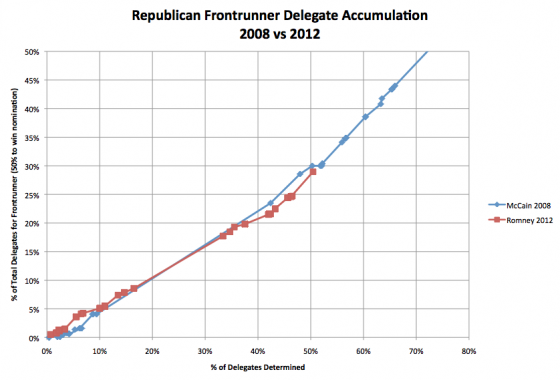
We’d last talked about this after Louisiana. But at that point in terms of % of delegates allocated the 2012 progress in the race still hadn’t gotten to where we were in 2008 immediately after Super Tuesday. We were in the 2008 “gap” caused by the large number of delegates allocated on Super Tuesday in 2008. At this point in the race, on April 4th, we are STILL not quite past where we were once all the 2008 Super Tuesday delegates were counted. But we are close…
And once again, we see that, yes, Romney is behind where McCain was at the corresponding place in the delegate hunt. But it is very close. It is not a big substantial difference. Right now we have 50.4% of the delegates allocated and Romney has 29.0% of them. On the day in 2008 we finally had all the results from Super Tuesday (February 9th) we had 52.1% and McCain had 30.0% of the delegates.
So Romney is 1.0% or so behind McCain’s pace from 4 years ago once you are looking at an even scale based on % of delegates determined so far. These lines fairly neatly track each other. There is NOT a substantial gap where Romney was underperforming McCain.
The perception certainly has been that there was. Romney having problems wrapping it up and such. But this is 100% due to the stretched out calendar. It is not due to winner take all vs proportional. It is just about the calendar. The fact that here on April 4th, we STILL haven’t allocated as many delegates as were allocated on February 9th back in 2008 is extraordinary. This is why it SEEMS like it has taken a lot longer to wrap things up… because it has! But in terms of the calendar only. The Republicans stretched out the whole race by spreading the contests out, so of course it takes more calendar time for the winner to consolidate their win. Duh.
But this doesn’t support the conclusion that Romney was somehow less able to consolidate Republican support than McCain was. They really have moved through the process at a remarkably similar rate.
It just doesn’t seem like it because the process is so stretched out this time.
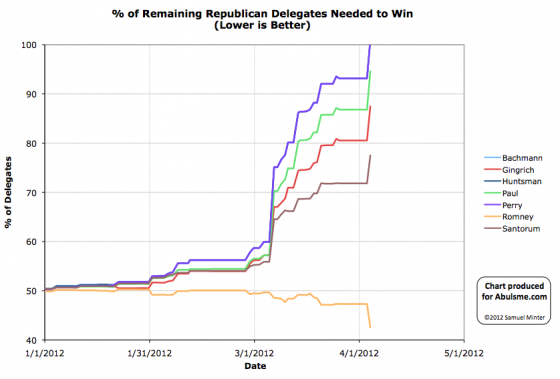
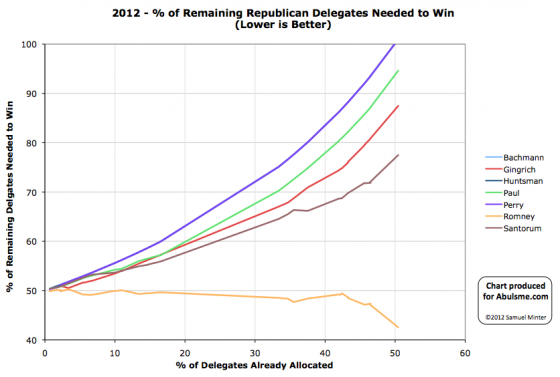
Charts from the Abulsme.com 2012 Republican Delegate Count Graphs page. When a candidate gets down to 0%, they have cinched the nomination. If they get up past 100%, they have been mathematically eliminated. The first chart is by date, the second is by “% of Delegates Already Allocated”. These numbers include estimates of the eventual results of multi-stage caucus processes which will be refined as the later stages occur.
So… this is it. Long ago any realistic possibility for any non-Romney to win the nomination disappeared. With today’s update the already long odds for the non-Romneys to keep Romney from getting to 1144 essentially drop to zero. This is over. Romney wins. Without any sort of brokered convention. For something else to happen now we’d need some event that was so earth shaking that Romney dropped out. This is extremely unlikely.
Details below.
We have updates from four contests. In alphabetical order:
- DC: DC is winner take all, Romney gets all 16 delegates.
- Maryland: Maryland is not actually winner take all, you get some delegates for winning the state, and then more delegates go to the winner of each congressional district. But Romney not only won the state, but every congressional district. So Romney gets all 37 delegates.
- North Dakota: North Dakota had the first round of its process in March. At that time the delegate estimate was Santorum 11, Paul 8 , Romney 7 , Gingrich 2. But the state Republican Convention happened last weekend, and Romney supporters owned the parliamentary process, taking the lion’s share of the delegates despite coming in third in March. That’s how it works in caucus states sometimes. It took a couple days for Green Papers to confirm a new estimate, but it now looks like Romney 20, Santorum 6, Paul 2. So the net today is Romney +13, Gingrich -2, Santorum -5, Paul -6.
- Wisconsin: Wisconsin also allocates some delegates based on both state and CD winners. Romney won the state. Romney won 5 CDs. Santorum won 3 CDs. So overall we have a delegate count of Romney 33, Santorum 9
Add those up and we have a net total for today of Romney +99, Santorum +4, Gingrich -2, Paul -6 Obviously Romney completely dominated the day.
In terms of “% of remaining delegates needed to win” we have this:
- Romney: 47.3% -> 42.5%
- Santorum: 71.8% -> 77.5%
- Gingrich: 80.5% -> 87.5%
- Paul: 86.8% -> 94.6%
The also-rans who left the race early on… Bachman, Huntsman and Perry… are mathematically eliminated after today. Paul, Gingrich and Santorum will inevitably join them soon.
The blocking Romney option? At this point the non-Romneys collectively would need to get 57.5% of the remaining delegates. So far they have managed 42.6% of the delegates. A change of this sort, while not mathematically impossible, would be unprecedented, especially since we are in the phase of the campaign where it is clear Romney is winning and the others are losing. People just stop voting for losers. As things go on, the % of delegates the non-Romneys get will probably actually decline. A major increase is just not going to happen.
It is over.
(We will of course continue to update these charts until Romney actually gets to 1144 however.)
Sometime a few weeks ago I looked at the upcoming states and misread something and got it stuck in my head that DC, MD and WI were all winner take all states. I then repeated that a number of times on this blog and in my podcast.
BUZZZ!!
DC is indeed winner take all, but MD and WI are only “Winner take all by State and Congressional District”. So some delegates are chosen winner take all by the state results, and then additional delegates are allocated for the winners of each congressional district. So not really WTA.
Oops. Sorry about that. In any case, when I post delegate updates they will of course reflect the actual delegate distributions, not my imaginary winner take all results. This does mean that today will probably not be quite as much of a knockout punch for Romney as I expected, but it is looking to still be a pretty decisive victory, certainly more than he needs to be on pace for 1144.
In the latest Curmudgeon’s Corner Sam and Ivan talk about:
- Election 2012
- Snohomish County Republican Convention
- Car Scratch / RIM Results
- Megamillions / April Fools
Just click to listen now:
[wpaudio url=”http://www.abulsme.com/CurmudgeonsCorner/cc20120401.mp3″ text=”Recorded 1 Apr 2012″]
or
 1-Click Subscribe in iTunes 1-Click Subscribe in iTunes
 View Podcast in iTunes View Podcast in iTunes
 View XML Feed View XML Feed
|
 |
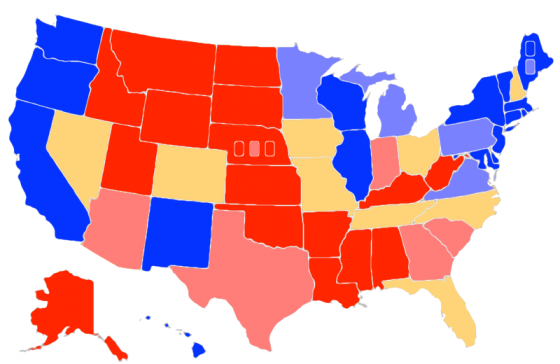
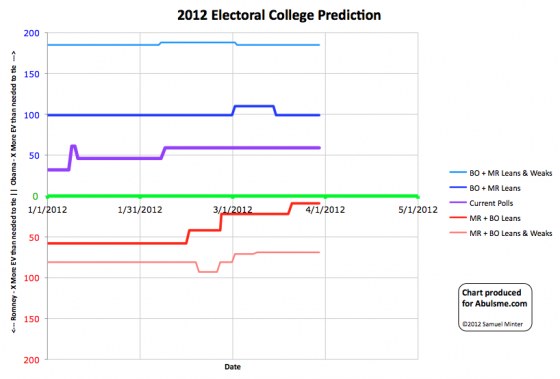
Map and chart from the Abulsme.com 2012 Electoral College Prediction page. Both assume Obama vs Romney with no third party strong enough to win states. Lines on the chart represent how many more electoral votes a candidate has than is needed to tie under several different scenarios. Up is good for Obama, Down is good for Romney.
So my update today included a new PPP poll in Nebraska. This poll included a breakdown by congressional district, which is useful because Nebraska is one of two states (the other is Maine) which currently have the potential of splitting their electoral college vote. Both states do this with 2 electoral votes going to the statewide winner, then 1 electoral vote for the winner of each congressional district. Thanks PPP for actually doing the CD split!!
Anyway, as I was adding the new data points for Nebraska at large and each of the three congressional districts, I noticed the previous data for the 1st and 2nd congressional districts included some errors. (Specifically the 2008 Republican and Democratic results were reversed… I use the 2004 and 2008 elections to seed the numbers for states that have had less than five actual Obama vs Romney polls.) The end result of this was that the 1st district had been classified as Weak Romney when it should have been Strong Romney, and the 2nd district was classified as Strong Romney when it should have been Weak Romney. I corrected this and the new poll results didn’t change the classifications again.
The net result of this is just that on the map I had the wrong one of the three boxes in Nebraska light red. It should have been the 2nd box instead of the 1st. This has now been corrected. Since both districts are one electoral vote and the changes balanced each other, the lines on the graph do not change at all.
The summary remains:
|
Romney |
Obama |
| Romney Best Case |
278 |
260 |
| Current Status |
210 |
328 |
| Obama Best Case |
170 |
368 |
Note 2012 May 23 10:43 UTC: Due to an error in my spreadsheet, a change in status for Wisconsin from Weak Obama to Strong Obama that should have been noted on this update on March 30th, was prematurely made on March 2nd. The corrected time series chart can be seen starting with the May 23rd update. Thanks to Darryl at HorsesAss for finding the mistake.
Note 2012 Jun 16 21:22 UTC: Actually, with more information, the Wisconsin transition should have happened on March 31st. See the correction on the June 19th update.
In the latest Curmudgeon’s Corner…Sam and Ivan talk about:
- Election 2012
- Delegate Prep
- Trayvon Martin
- Flash Crashes / Cheney
Just click to listen now:
[wpaudio url=”http://www.abulsme.com/CurmudgeonsCorner/cc20120325.mp3″ text=”Recorded 25 Mar 2012″]
or
 1-Click Subscribe in iTunes 1-Click Subscribe in iTunes
 View Podcast in iTunes View Podcast in iTunes
 View XML Feed View XML Feed
|
 |
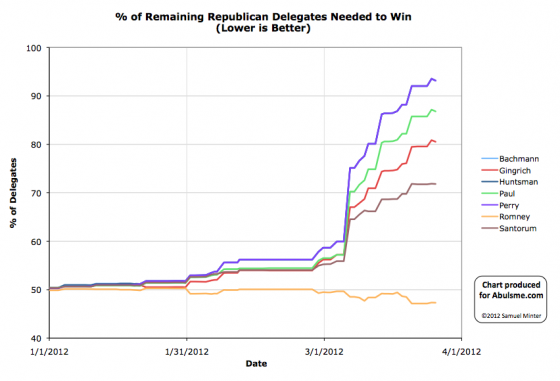
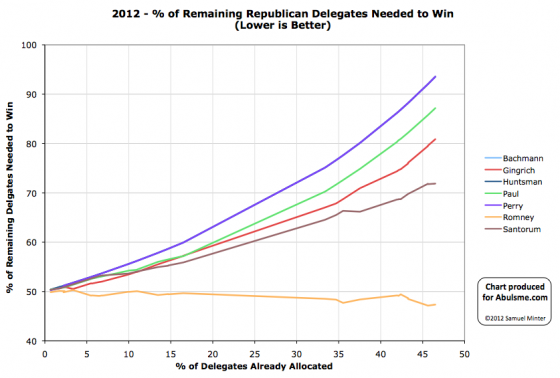
Charts from the Abulsme.com 2012 Republican Delegate Count Graphs page. When a candidate gets down to 0%, they have cinched the nomination. If they get up past 100%, they have been mathematically eliminated. The first chart is by date, the second is by “% of Delegates Already Allocated”. These numbers include estimates of the eventual results of multi-stage caucus processes which will be refined as the later stages occur.
I mentioned yesterday that there was some disagreement on interpretation of the rules for how delegates would be allocated in Louisiana. Green Papers said Santorum 13, Romney 7. @FHQ said Santorum 10, Romney 5 and some uncommitted delegates. My charts use the Green Papers Numbers. Well, since yesterday’s update the Louisiana Republican party weighed in… and it was 10-5, not 13-7. So @FHQ was right and wins that argument. So Green Papers updated their numbers.
So, net for today: Santorum -3, Romney -2.
This adjusts the numbers slightly, but does not change yesterday’s conclusions. Both Romney and Santorum didn’t do as well as they needed in Louisiana to move toward 1144. So it was still an “everybody loses” contest. Just slightly different numbers.
For today’s adjustment, the “% of remaining needed to win” changes like this:
- Romney: 47.34% -> 47.31%
- Santorum: 71.87% -> 71.82%
- Gingrich: 80.87% -> 80.54%
- Paul: 87.16% -> 86.81%
So essentially today is an “everybody wins!” day, simply because there are 5 more delegates available today compared to what was thought to be available yesterday.
The race summary remains the same. The non-Romneys are rushing toward mathematical elimination. It would take an event like Romney dropping out to give them an actual shot to get to 1144 before the convention. The most likely scenario remains Romney slowly but surely accumulating delegates and getting to 1144. The possibility of the non-Romneys blocking Romney from getting to 1144 remains remote, but not yet so remote that I’m ready to say outright that it is impossible.
I had promised an update of the 2008 vs 2012 frontrunner graph after Louisiana. I had thought we would have about 52% of the delegates allocated (or estimated) at this point, but I was wrong. States responsible for about 52% of the delegates have “started their process” according to Green Papers, but not all of those delegates are determined yet, for a variety of reasons. Instead, we are only at about 47%.
52% is a good place to compare because that is where things were in 2008 right after Super Tuesday was all settled. In 2008 we were closest to the 47% mark on February 7th, which was after Super Tuesday, but still with only partial results from those contests. So the comparison will be better after we get past that point.
In any case, here is the update after Louisiana:
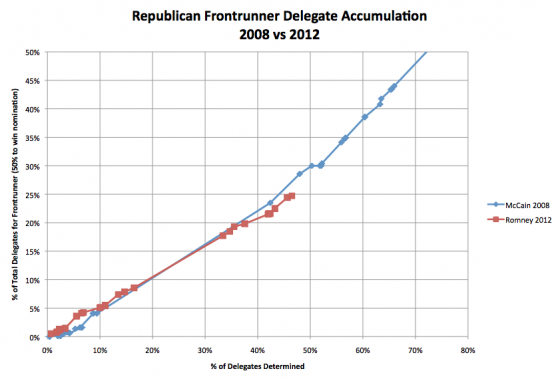
Romney is still behind McCain’s pace four years ago, but not by very much. It isn’t a dramatic difference. It just FEELS like it is because of the very different calendars in 2008 vs 2012. But really, the two candidates are tracking each other pretty closely by this analysis.
The chart by Seth at Enik Rising still shows a much bigger apparent difference. (As of when I write this, he has updated for Illinois, but not Louisiana.)
In my previous analysis I’d determined that the two graphs actually have very similar data. The difference in how they are perceived is due to three main factors:
- I connect the dots for each day, while ER does a linear regression. Since ER’s linear regression includes data from after when McCain was the clear winner in 2008, it pulls the McCain line up further on his chart than if he only included data up to the same % we are in the 2012 race.
- I have daily data points from both 2008 and 2012, compared to data only with the final full results at ER. The partial results in the days after Super Tuesday in 2008 keep McCain’s line a little lower than if you had just drawn a straight line from before Super Tuesday to the first data point after complete Super Tuesday results were available.
- He’s got a taller vertical scale, which means psychologically the vertical gaps look bigger on his chart than mine, even if they are really about the same.
Anyway, interesting to look at the data in these two different ways.
DC, Maryland and Wisconsin happen on April 3rd… all winner take all. There are no polls in DC and Maryland, but those don’t seem like Santorum country. The most recent poll in Wisconsin, a Rassmussen poll (the only one taken in March so far) has Romney ahead.
If Romney does win all three of those contests, we’ll be at 51% of the delegates allocated (or estimated) and Romney will ALMOST have caught up to McCain’s pace in 2008. (Romney will have 29% of the total delegates, where at the comparable point McCain had 30%.)
We’ll see if that is how it plays out. I’ll do another update of this chart after we have those results.
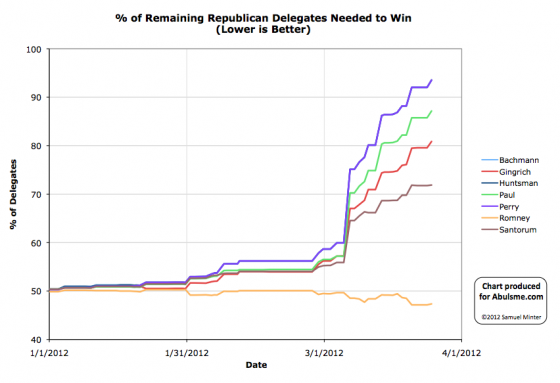
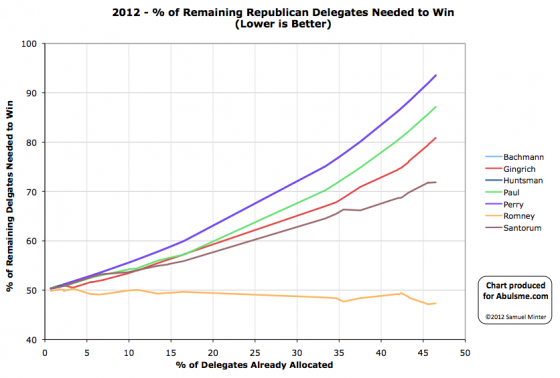
Charts from the Abulsme.com 2012 Republican Delegate Count Graphs page. When a candidate gets down to 0%, they have cinched the nomination. If they get up past 100%, they have been mathematically eliminated. The first chart is by date, the second is by “% of Delegates Already Allocated”. These numbers include estimates of the eventual results of multi-stage caucus processes which will be refined as the later stages occur.
So, Santorum has a “big win” in Louisiana. But, unfortunately for him, not big enough. Green Papers’ Louisiana Results give 13 delegates to Santorum and 7 to Romney. Gingrich and Paul get nothing. Louisiana also has 26 more delegates that will be determined by other means. (Note that there is some question on interpretation of the delegate rules. @FHQ says 10 Santotum, 5 Romney and some uncommitted delegates. We use Green Papers as our source, and they will update if it becomes clear their interpretation of the rules was wrong.)
So with a 13-7 split, that is 65% Santorum. To actually be on a pace to catch up and win, he needed to get 71.8% of the delegates. Didn’t happen. Thus with his “big win” Santorum still moves closer to mathematical elimination. That is some win!
Of course, Romney also didn’t get the delegate levels he needed to be on the pace he needs. He needed 47.1% of the delegates. The 35% he gets with his 7 delegates is well below that.
So, it’s an “everybody loses!” day. Bottom line is that Louisiana doesn’t change much. The three non-Romney’s are racing inevitably toward elimination. They are just too far behind to catch up absent something as major as Romney dropping out of the race… which I don’t think Romney is thinking about doing at this point. Meanwhile, Romney is in a position to eventually win just by continuing to collect delegates at the same pace he has been. Romney has collected 53% of the delegates so far. If he just keeps chugging at those margins, he’ll get to 1144 eventually. But… the non-Romney’s collectively have gotten 47% of the delegates. If they can up that to 53%, then they can still collect enough delegates to block Romney.
47% to 53% is a big move in a political race. But it is still not out of the realm of the possible. (It is getting close though.) A few big slips by Romney. One of the non-Romney’s doing something really impressive. It COULD happen. It is unlikely though. As I’ve said before here, as it becomes clear that none of the non-Romney’s can actually win, it will be harder and harder for them to actually get delegates. So it is far more likely that the percentage of delegates the non-Romneys can manage will decline as we go forward.
“% of remaining needed to win” update based on today’s numbers:
- Romney: 47.1% -> 47.3%
- Santorum: 71.8% -> 71.9%
- Gingrich: 79.6% -> 80.9%
- Paul: 85.8% -> 87.2%
We’re still not quite to the half way mark. 46.5% of the delegates allocated (or estimated) at this point.
Next up: DC, Maryland, Wisconsin on April 3rd. All winner take all states, so likely to have a bigger impact.
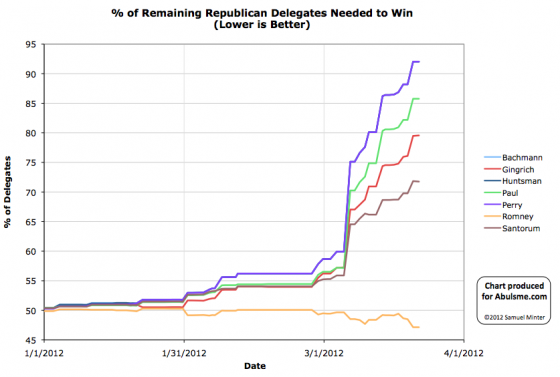
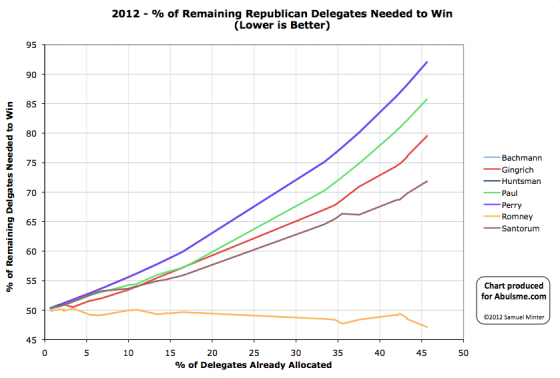
Charts from the Abulsme.com 2012 Republican Delegate Count Graphs page. When a candidate gets down to 0%, they have cinched the nomination. If they get up past 100%, they have been mathematically eliminated. The first chart is by date, on the second chart rather than the date on the x-axis, we show the “% of Delegates Already Allocated” as this better represents the progress through the race. Note that these numbers include estimates of the eventual results of multi-stage caucus processes which will be refined as the later stages occur.
Right after the caucuses there, delegates from Alaska were estimated as Romney 8, Santorum 7, Paul 6, Gingrich 3. The district Convention vote is now final, and the estimate changes to Romney 8, Santorum 8, Paul 6, Gingrich 2. So net for the day: Santorum +1, Gingrich -1. (The three superdelegates from Alaska are still up for grabs.)
This of course doesn’t substantially change anything.
(For the die hards: Santorum’s % of remaining needed to win declines from 71.84% to 71.76%, while Gingrich’s rises from 79.49% to 79.57%.)
|
|












